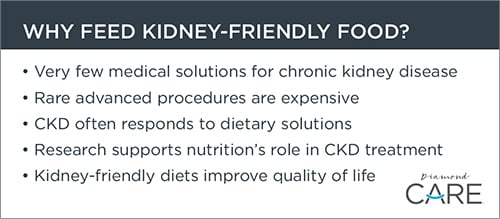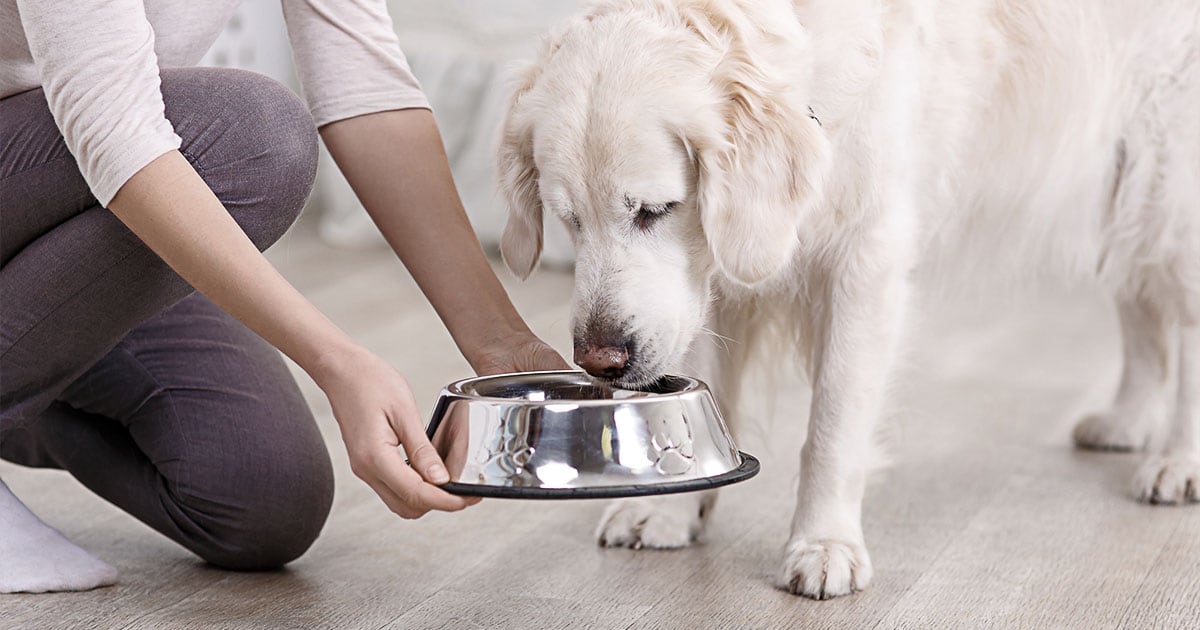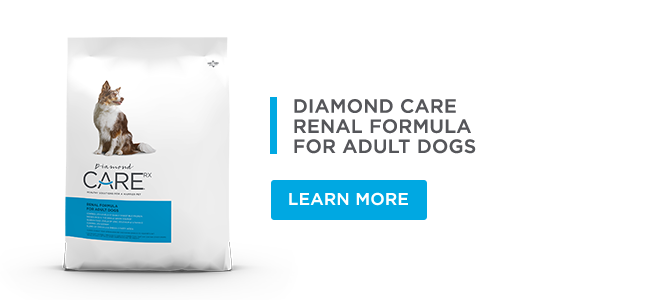Your veterinarian recently diagnosed your dog with chronic kidney disease (CKD) and recommended a special, kidney-friendly diet as a part of your dog’s treatment plan. But now you’re wondering if you should spend the extra money for the prescribed dog food. The short answer is a resounding “Yes!”
Why feed a kidney-friendly dog food?
According to specialists in veterinary nutrition and internal medicine, the right diet is arguably the most important — and most successful — component of your dog’s CKD treatment plan. What many pet parents don’t realize is that CKD in dogs is a disease for which veterinarians have very few good medical options, especially ones that have been shown to improve the quality and length of a dog’s life. Advanced medical procedures such as dialysis and kidney transplantation aren’t available in most places, and even if available, they’re prohibitively expensive for most dog owners. However, kidney disease often responds to diet changes, and research supports the role of nutrition as a critical part of treatment.
In a University of Minnesota study, dogs with CKD were fed either a kidney-friendly dog food or a typical adult maintenance dog food, and their kidney disease progression was monitored over 24 months. Researchers found that dogs fed the kidney-friendly diet survived at least 13 months longer than those dogs fed the maintenance diet. Owners whose dogs were fed the special diet also said their dogs had a better quality of life.
Similar studies have been done with cats and have shown similar results: a slowing of CKD progression and improved quality of life.

How and why kidney diets are different
A common misconception is that kidney-friendly pet foods are simply low-protein diets. But in reality, kidney diets such as Diamond CARE Rx Renal Formula for Adult Dogs are formulated to be different from maintenance foods in ways other than reduced protein, including controlled amounts of phosphorus and sodium, higher levels of omega-3 fatty acids, and additional antioxidants and fiber. Let’s take a closer look at the key nutrients that may be modified in a kidney-friendly dog food.
Controlled phosphorus level
Phosphorus, the second most abundant mineral in the body and found mostly in bones and teeth, is essential for normal cell function. Any extra phosphorus is removed from the body by the kidneys. But during CKD, the kidneys are unable to get rid of phosphorus like they normally would, which leads to a buildup of phosphorus in the blood. Left untreated, high blood phosphorus levels can lead to a vitamin D deficiency, loss of bone minerals and mineral deposits in soft tissues such as the kidneys.
Veterinarians now know that restricting phosphorus is essential to managing their patients’ CKD — possibly even more important than protein in terms of nutrition.
Kidney-friendly diets contain regulated amounts of phosphorus to help manage blood levels. Because many meat-based proteins have a high phosphorus content, reducing the food’s protein level also helps reduce the food’s total phosphorus content.
Reduced, yet adequate, protein level
Kidney-friendly dog foods contain less protein compared to adult maintenance dog foods. However, the protein used in kidney diets is typically high-quality protein that results in less waste when digested, and that means less work for the kidneys.
Protein is still needed by the dog’s body to repair cells and tissues. Kidney-friendly dog food provides enough protein to meet the body’s needs for maintaining muscle, immunity and wound healing, yet helps reduce the workload of the kidneys.
Regulated sodium level
Sodium is a mineral found in blood and in fluid that surrounds cells and helps prevent cells from either swelling or becoming dehydrated. Sodium also plays an important role in proper nerve and muscle activity. Although normal dogs may not be salt-sensitive, dogs with kidney disease may be affected by a food’s sodium content. Reducing the amount of sodium consumed in the diet helps reduce the chances of increased blood pressure and progression of CKD. However, too little sodium may also be harmful to dogs with kidney disease.
Increased levels of omega-3 fatty acids
The omega-3 fatty acids EPA (eicosapentaenoic acid) and DHA (docosahexaenoic acid) are essential fatty acids, meaning they aren’t made in the body and need to be obtained from the diet. In particular, EPA and DHA help reduce inflammation and have been shown to lower pressure in a key kidney structure (the glomerulus) and improve removal of a key waste product (creatinine), consequently improving kidney function.
More antioxidants
Antioxidants, such as vitamins C and E, help neutralize free radicals that otherwise may cause cell damage. Kidney-friendly diets that have both omega-3 fatty acids and increased levels of antioxidants are better at slowing the progression of CKD than either omega-3 fatty acids or antioxidants alone.
Other characteristics of kidney diets
Some kidney-friendly dog foods have other beneficial features such as added soluble fiber, increased calories and buffering agents such as potassium citrate.
Soluble fiber helps promote the growth of bacteria in the colon. These bacteria use urea, a waste product of protein digestion, to make new proteins. The end result is that urea is then removed from the body through stool, rather than through the kidneys or accumulating in the blood.
Increased calories address a common problem in dogs with CKD: nausea and decreased appetite, especially as the condition progresses. To help dogs consume enough calories, kidney diets are formulated to be higher in calories, or “calorie dense,” and contain moderate to high levels of fat. The fat and carbohydrates in kidney-friendly dog foods are used for energy, leaving protein to be used to maintain body tissues and support the immune system. Increased fat also helps make the food taste good despite decreased protein levels.
Buffering agents help maintain appropriate blood pH. Pets with kidney disease often have increased blood acidity as a result of the waste products building up in their blood. Kidney diets tend to be formulated to help counteract this issue.
A specially formulated, kidney-friendly food can have a significant impact on your dog’s health. If you have any questions or concerns, be sure to discuss them with your veterinarian.








